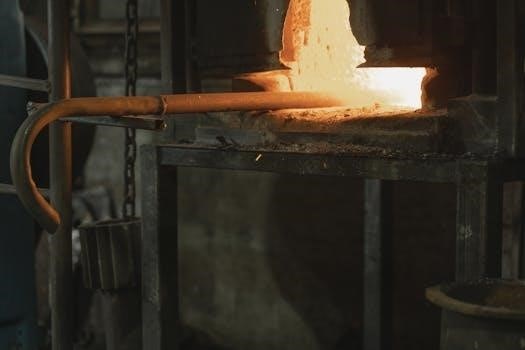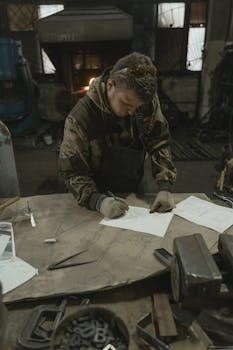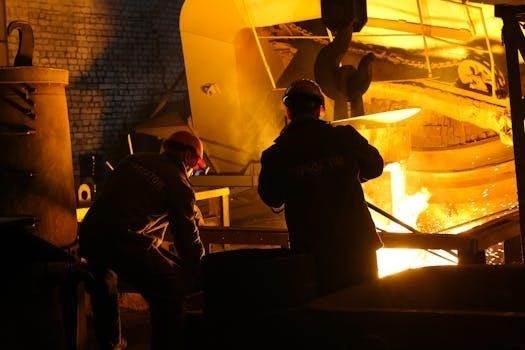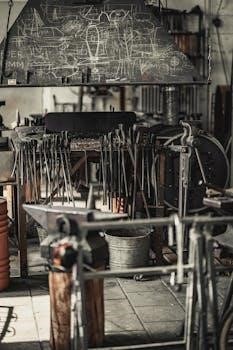Goodman Furnace Troubleshooting⁚ An Overview
Goodman furnace troubleshooting involves identifying issues that may arise during operation. These range from simple problems like a dirty filter to complex malfunctions such as faulty sensors or control board errors. DIY troubleshooting tips and error codes are available.
Understanding Common Issues
Several factors can hinder a Goodman furnace’s performance, preventing it from heating correctly or at all. These issues can stem from various sources, including faulty parts, incorrect thermostat settings, or a tripped circuit breaker. Common problems include a clogged air filter, which can restrict airflow and cause overheating, and ignition problems, such as a faulty igniter or gas valve. Thermostat malfunctions and power supply issues are also frequent culprits. Additionally, the system might be experiencing a lack of gas supply. Furthermore, it is essential to consider the possibility of malfunctioning components, such as a faulty flame sensor or pressure switch. Understanding these common issues is crucial for effective troubleshooting and can often lead to a quick resolution. Error codes provide valuable diagnostic information that can pinpoint the specific problem.
Initial Checks and Basic Troubleshooting
Before diving into complex issues, start with basic checks. This includes examining the circuit breaker, inspecting the air filter, and, if applicable, ensuring the pilot light is lit. These simple steps can resolve many problems.
Checking the Circuit Breaker or Fuse Box
If your Goodman furnace isn’t turning on, the first step in troubleshooting should always involve checking the circuit breaker or fuse box. A tripped circuit breaker or a blown fuse can easily halt the furnace’s operation. Locate the breaker dedicated to your furnace within your electrical panel. If the switch is in the off or tripped position, reset it by moving it to the ‘off’ position and then back to the ‘on’ position. If the circuit trips again, it may indicate a more serious electrical issue that requires professional attention. If your home uses fuses, examine the fuse for the furnace. A blown fuse will have a broken wire inside or show signs of scorching. If you find a blown fuse, replace it with one of the correct amperage. If the new fuse blows immediately, further electrical troubleshooting may be necessary by a qualified technician. Remember to always turn off the power before making any electrical checks.
Inspecting the Air Filter
A clogged or dirty air filter is a common cause of Goodman furnace issues, and inspecting it should be a routine part of troubleshooting. A dirty filter restricts airflow, which can cause the furnace to overheat and trigger safety shutoffs. This can manifest as the furnace not heating or blowing cold air. To inspect the filter, locate the filter slot, usually near the furnace or return air duct. Remove the filter and examine its condition. If the filter is visibly dirty, clogged with dust or debris, it needs to be replaced. A clean filter ensures proper airflow and helps the furnace operate efficiently. Regularly changing your air filter, as recommended by the manufacturer, can prevent many common problems and extend the lifespan of your Goodman furnace. It is important to make sure you use the correct filter size and type for your specific model. Replacing it with the wrong size can cause further problems.
Examining the Pilot Light (if applicable)
If your Goodman furnace uses a pilot light, examining its status is crucial for troubleshooting heating issues. A pilot light that is out, or flickering erratically, can prevent the furnace from igniting and producing heat. To check the pilot light, locate the pilot light assembly, usually near the burner compartment. Observe if the pilot flame is present, and ensure that it is a strong, blue flame. If the pilot is out, you may need to relight it according to the furnace’s instructions. If the flame is weak or yellow, it could indicate a problem with the gas supply or a dirty pilot assembly. If the pilot light goes out repeatedly, this suggests an underlying issue that requires further investigation, such as a faulty thermocouple or a problem with the gas valve. Always follow the manufacturer’s safety instructions when dealing with pilot lights. If you are uncomfortable with this process, it’s best to seek professional help.

Troubleshooting Specific Problems
When dealing with specific furnace issues, understanding the problem is key. Issues like no heat or blowing cold air need particular attention. Possible causes include thermostat settings, and malfunctioning parts.
Furnace Not Heating
If your Goodman furnace isn’t producing heat, several factors could be at play. Begin by checking the thermostat to ensure it’s correctly set to ‘heat’ and the temperature is higher than the room temperature. Power issues are another concern; verify the circuit breaker or fuse box hasn’t tripped or blown a fuse. A gas supply problem could also prevent heating; confirm the gas valve is open and that there are no issues with the gas line. Ignition problems are common, where a faulty igniter or gas valve may prevent the flame from igniting. Additionally, malfunctioning components like the flame sensor could be responsible for the furnace not heating. The troubleshooting manual provides guidance, and if the problem persists, it’s best to call a professional HVAC technician.
Furnace Blowing Cold Air
When your Goodman furnace is blowing cold air instead of heat, a few common issues might be the cause. Firstly, examine the air filter. A clogged air filter restricts airflow and may cause the system to overheat, triggering a safety shutoff which results in cold air. If your furnace has a pilot light, check to make sure it’s lit. If the pilot light is out, follow the relighting procedure outlined in your manual. Another possibility is the thermostat; make sure it’s set correctly to heat and that the desired temperature is higher than the current room temperature. If these are not the issues, there could be a problem with the gas valve or the igniter, preventing the burners from igniting. If these checks don’t resolve the issue, it’s recommended to call a professional HVAC technician.

Identifying and Resolving Error Codes
Goodman furnaces often display error codes to indicate problems. Use the Goodman furnace error flash chart to decode them. Follow troubleshooting steps or seek professional help to resolve these issues.
Utilizing the Goodman Furnace Error Flash Chart
The Goodman furnace error flash chart is an essential tool for diagnosing issues with your heating system. This chart helps you understand the specific problems your furnace is experiencing by decoding the error codes displayed through flashing lights. These codes often point to specific malfunctions within the unit, such as a faulty flame sensor, pressure switch issues, or ignition problems. By referring to the chart, you can quickly narrow down potential causes of your furnace’s malfunction. The error flash chart serves as a guide for troubleshooting, directing you towards the appropriate repair steps, and helping you determine whether the problem can be resolved with DIY methods or professional assistance. Understanding this chart can save you time and money by providing a clear starting point for your troubleshooting efforts, ensuring you can get your furnace back to functioning correctly.
Understanding Common Error Codes
Common error codes on a Goodman furnace often indicate specific issues that need addressing. For example, a fault code might point to a dirty or worn flame sensor, requiring cleaning or replacement. Error codes related to the pressure switch may suggest problems with airflow or venting, and codes indicating ignition failure could signal issues with the igniter or gas valve. These codes are crucial for understanding what part of the system isn’t functioning correctly. Decoding these codes, often using the Goodman error flash chart, helps narrow down the problem and allows for more targeted troubleshooting. Knowing the meaning of these error codes is an important step towards resolving common problems and ensuring your furnace operates efficiently, whether through DIY repairs or when seeking professional assistance from an HVAC technician. Addressing these common issues promptly can prevent further damage and save you on costly repairs.

Addressing Ignition Problems
Ignition problems in a Goodman furnace often stem from a faulty igniter or gas valve. These issues lead to heating system malfunctions. Check the components and seek assistance if needed.
Checking the Igniter
A malfunctioning igniter is a common culprit behind ignition problems in Goodman furnaces. The igniter’s role is to heat up and ignite the gas, starting the combustion process. If the igniter fails, the furnace will not produce heat. To check the igniter, first, ensure the power to the furnace is turned off. Locate the igniter, which is usually near the burner assembly. Visually inspect it for any signs of damage, such as cracks or burnout. If the igniter appears intact, you can use a multimeter to test its resistance. Consult your Goodman furnace manual for the proper resistance reading. If the igniter fails the resistance test, or if you see signs of damage, you’ll likely need to replace the igniter. Always refer to your furnace’s manual for safe and accurate replacement procedures or consult a professional.
Assessing the Gas Valve
A faulty gas valve can also be the reason behind ignition issues with a Goodman furnace. The gas valve is responsible for regulating the flow of gas to the burners. If the gas valve is not functioning correctly, the furnace may not ignite or may experience intermittent heating. Begin by verifying that the gas supply to the furnace is turned on. Then, carefully inspect the gas valve for any visible damage, such as leaks or corrosion. If the valve is powered by electricity, use a multimeter to check for voltage at the valve terminals when the furnace is attempting to start. If there’s no voltage, or the valve is faulty, professional help might be required. Never attempt to disassemble or repair the gas valve yourself due to safety reasons. Contact a qualified HVAC technician for proper assessment and repair of gas valve issues.

When to Seek Professional Help
If you encounter complex issues, such as faulty sensors, control board malfunctions, or gas valve problems, it is crucial to seek assistance from a qualified HVAC technician. Professional help ensures safe and accurate repairs.
Recognizing Complex Issues
Identifying complex issues in a Goodman furnace often requires a deeper understanding of its intricate components. Problems that extend beyond basic checks, such as a clogged filter or a tripped breaker, signal the need for professional intervention. Specifically, if you notice recurring ignition problems, erratic cycling, or if error codes persist even after basic troubleshooting, it’s a strong indicator of a more significant underlying issue. Additionally, any problems involving the gas valve, the control board, or the flame sensor, typically require specialized tools and expertise. If the furnace continues to short-cycle, even after opening all registers, it could point to more profound issues. Trust your intuition if the furnace continues to malfunction despite your best efforts. These situations are best handled by certified technicians who can diagnose problems accurately and safely.
Importance of HVAC Technicians
The importance of HVAC technicians in maintaining your Goodman furnace cannot be overstated, especially when dealing with complex issues. These professionals possess the necessary knowledge, tools, and experience to safely and effectively diagnose and resolve intricate problems. They are trained to identify subtle malfunctions that may not be apparent to the average homeowner. Attempting to fix complex issues without proper training can lead to further damage, potential safety hazards, and costly repairs down the line. HVAC technicians are skilled in handling sensitive components like gas valves, control boards, and flame sensors. Their expertise ensures that your furnace operates safely and efficiently, providing reliable heat for your home. Calling a professional can also save time and prevent further complications. Remember that licensed technicians have access to the latest diagnostic equipment and repair techniques. Therefore, when a problem surpasses basic troubleshooting, a qualified HVAC technician is your best resource.
